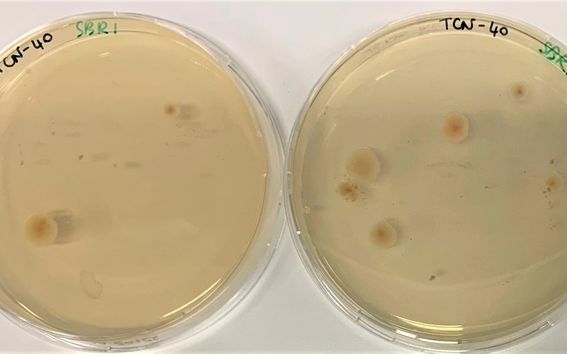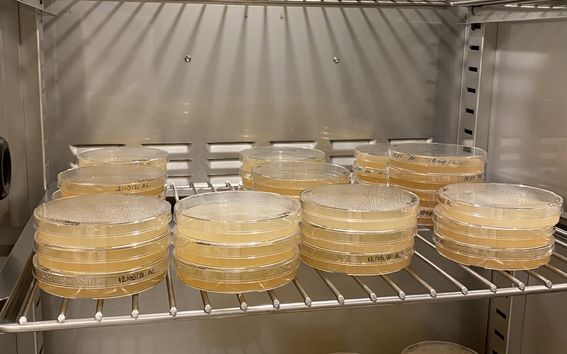The role of wastewater treatment plants in the global health threat of 21st century
During the times of Covid-19, the threat diseases, which may not have cure have become highly acknowledged. The spread of antibiotic resistant organisms may have the same effect and it is a serious health threat, which concerns us globally. Many of us know that the antibiotic resistance grows with the overuse of antibiotics as medicines, but there is also another source that spreads the antibiotic resistant genes to environment: the water that leaves the wastewater treatment plants.
Different antibiotics and pharmaceuticals end up in wastewaters after being used and affect the wastewater bacteria helping them to become antibiotic resistant. Therefore, the wastewaters that enter the environment contain antibiotic resistant bacteria. Postdoctoral researcher Antonina Kruglova has focused on Finnish wastewater treatment plants as hot spots for spreading antibiotic resistance in her research. ‘Wastewater treatment plants are a collecting point for all chemicals and gut bacteria and the final barrier, before the waters are released to environmental waters’, she tells. Her research was funded by the Nessling Foundation.
Besides wastewaters, the antibiotic resistance can also spread through the sludge, which is another end product of wastewaters, which also enters the environment. This sludge can be utilized for circular economy, but its role in spreading the antibiotic resistance is not well-known yet. Doctoral student Maria Valtari’s research is focused on antibiotic resistance of sludge at wastewater treatment plants. This means that both Kruglova’s and Valtari’s research topics are related to the spread of antibiotic resistance through wastewater treatment, but focused on different end-products.

The use of antibiotics and pharmaceuticals shows in wastewater
The spread of antibiotic resistance in wastewaters varies globally a lot and even within the EU. This is due to the use of specific antibiotics, regulations and prescriptions in different countries. In some countries antibiotics are more available without prescriptions than in others and this affects the concentrations in wastewaters.
The antibiotic resistance does not stay within the state borders though. ‘The antibiotic resistance can be distributed from a state to another when people travel.’, Valtari tells. Kruglova’s and Valtari’s research also found multidrug-resistant bacteria from the wastewaters, which cannot be connected to one specific antibiotic. These super-bacteria have a very general resistance against different antibiotics. “This means that no matter what kind of antibiotics we have in wastewaters, there can still be resistant bacteria. We studied in parallel both antibiotics and the multidrug-resistant bacteria.”, Kruglova tells.
Also, what affects the formation of antibiotics resistance in wastewaters is other pharmaceuticals. ‘When entering the wastewater pharmaceuticals affect other bacteria and make them resistant also to antibiotics. Therefore, besides antibiotics our study included different types of pharmaceuticals in wastewater.’, Kruglova adds.

Antibiotic resistance in Finnish wastewaters
Although the threat caused by antibiotic resistance is globally increasing, the current situation in Finland is better than in many other places. ‘In Finland, urban wastewater is treated, and Finnish wastewater treatment plants are generally very efficient, which means that the situation is better, but this is not the case everywhere.’ Valtari comments.
‘The Finnish wastewater treatment plants are able to remove most of the pollutants and almost all bacteria from wastewaters’, Kruglova comments. However, Kruglova’s research found more than 100 antibiotic resistant genes including multidrug-resistant genes from the wastewaters, which come out of treatment plants. ‘We focused on the most popular antibiotics in our research and could see that the trend is similar in Finland and globally, although the situation is better in Finland.’, Kruglova adds.
However, there are some differences even within Finland. Kruglova found out that the specific concentrations were higher and different antibiotic resistant genes were not present in all places. Also, the results can vary from a day to another. ‘There is a lot of variation between places and this makes forming of the whole picture more complicated’, Kruglova tells.
‘When it comes to antibiotic resistant sludge, the differences in wastewater treatment processes matter more than regional differences.’, Valtari says. Valtari’s research included six large and middle scale wastewater treatment plants in Finland.
How to tackle antibiotic resistance in wastewater treatment plants?
When the antibiotic resistant genes enter the wastewaters, they spread to the environment and by the time goes by, they affect more and more on the general efficiency of antibiotics. The same concerns the sludge. ‘Also, what needs to be emphasized is that when wastewater treatment plants remove nearly all the bacteria from water, that removed bacteria stays in the sludge. This needs to be taken into account when sludge is utilized for circular economy, and we need to know more about it.’, Valtari tells.
When it comes to how to remove antibiotic resistant bacteria from wastewater, Kruglova’s research found out that the use of membranes in wastewater treatment plants can stop 99,9% of bacteria and viruses. Other solutions can be advanced oxidation processes, different ways to treat the wastewater in the final steps of the process and polishing treatment for water. Pharmaceuticals in wastewaters also need to be taken into account in wastewater treatment processes as they boost the antibiotic resistance and also form other types of problems for the environment.
‘When it comes to the sludge, we first need to understand how the antibiotic resistance is affected by the sludge treatment processes and what could be done in existing process phases’, Valtari tells about how to treat the sludge in wastewater treatment plants. Valtari’s research on the antibiotic resistance in sludge and its removal still continues.
‘The processes are already existing for removing the bacteria and we just want to optimize them’, Kruglova tells. In Finland also the climate temperature conditions affect the removal processes as they become slower at low temperatures, but at the same time, also the bacteria grow slower in these temperatures. ‘Wastewater treatment plants in Finland are modern, but they are not designed to remove pharmaceuticals or antibiotic resistance, because there are no regulations. Now the level of antibiotic resistance removal is just a side effect of the long-existing water treatment processes.’ Kruglova and Valtari conclude.
More information:
Postdoctoral researcher Antonina Kruglova
[email protected]
Doctoral student Maria Valtari
[email protected]
- Published:
- Updated:
Read more news

DeployAI Partners Gather for Heart Beat Meeting in Helsinki
The European DeployAI project's partners gathered for the Heart Beat meeting hosted by Aalto University Executive Education in Helsinki.
Get to know us: Associate Professor Maria Sammalkorpi
Sammalkorpi received her doctorate from Helsinki University of Technology 2004. After her defence, she has worked as a researcher at the Universities of Princeton, Yale and Aalto.
Aalto computer scientists in ICML 2024
Computer scientists in ICML 2024